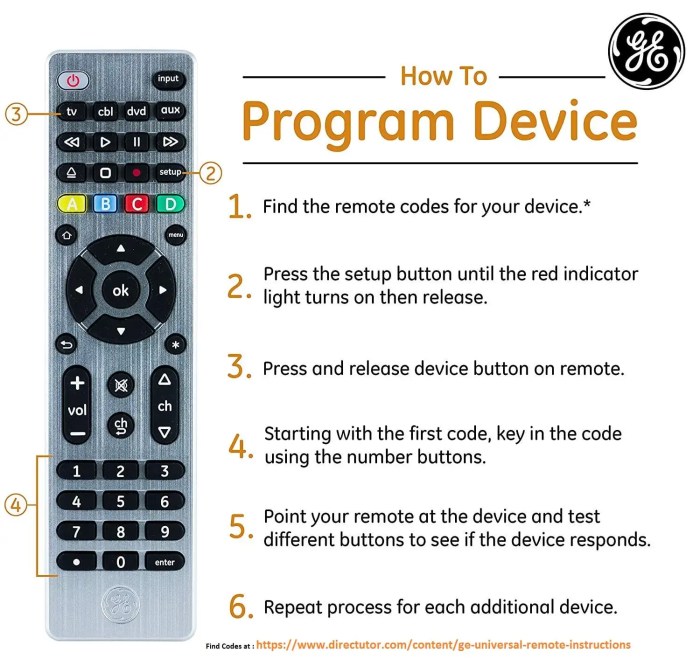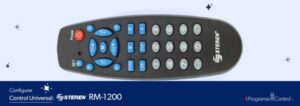In the realm of home entertainment, universal remotes reign supreme, offering the unparalleled convenience of controlling multiple devices with a single wand. However, unlocking the full potential of these versatile gadgets requires a touch of technical finesse. Embark on this comprehensive journey as we delve into the intricacies of programming a universal remote, empowering you to master the art of effortless device control.
From deciphering remote control protocols to exploring cutting-edge advancements, this guide will equip you with the knowledge and skills to transform your universal remote into an indispensable tool. Get ready to unlock a world of seamless entertainment and effortless device management.
Understanding Remote Control Protocols

Universal remotes communicate with devices using specific protocols. These protocols define the language and commands used to control devices.
Infrared (IR) Protocol
IR remotes emit infrared light pulses that are detected by the device's receiver. This protocol is widely used due to its low cost and ease of implementation.
- Advantages:Inexpensive, widely supported.
- Disadvantages:Line-of-sight required, limited range.
Radio Frequency (RF) Protocol
RF remotes use radio waves to communicate with devices. This protocol offers greater range and flexibility than IR, as it does not require line-of-sight.
- Advantages:Long range, no line-of-sight required.
- Disadvantages:More expensive, potential interference from other devices.
Bluetooth Protocol
Bluetooth remotes use wireless technology to communicate with devices. This protocol provides secure, two-way communication and allows for more advanced features.
- Advantages:Secure, two-way communication, supports advanced features.
- Disadvantages:Limited range, requires Bluetooth-enabled devices.
Wi-Fi Protocol
Wi-Fi remotes connect to devices over a Wi-Fi network. This protocol offers the widest range and allows for control from anywhere within the network's reach.
- Advantages:Unlimited range, control from anywhere.
- Disadvantages:Requires Wi-Fi network, may be susceptible to security vulnerabilities.
Programming Methods
Programming a universal remote enables you to control multiple devices with a single remote. There are various methods to program a universal remote, including auto-search, manual code entry, and smartphone apps.
The specific steps for programming your universal remote may vary depending on the model and brand. However, the general process remains similar.
Auto-Search Method
The auto-search method is a convenient way to program your remote without having to manually enter codes. To use this method:
- Turn on the device you want to control.
- Point the universal remote at the device and press the "Auto-Search" button.
- The remote will start searching for compatible codes.
- Once the remote finds a compatible code, it will send a signal to the device. If the device responds, the remote is programmed.
Manual Code Entry
If the auto-search method does not work, you can manually enter the code for your device. To do this:
- Find the code for your device in the user manual or on the manufacturer's website.
- Turn on the device you want to control.
- Point the universal remote at the device and press the "Code Entry" button.
- Enter the code for your device using the number buttons on the remote.
- Once you have entered the code, press the "Enter" button.
Smartphone Apps
Some universal remotes can be programmed using smartphone apps. These apps typically allow you to search for codes, enter codes manually, and control your devices remotely.
To use a smartphone app to program your remote:
- Download the app for your remote.
- Follow the instructions in the app to add your devices.
- Once you have added your devices, you can use the app to control them.
Customizing Remote Functions

Universally, remote controls are crafted with standard button configurations. Nevertheless, it's possible to tailor these buttons to align precisely with your specific device preferences, granting you an unparalleled level of control over your home entertainment setup.
Assigning Buttons to Devices
The ability to assign specific buttons to control different devices is a cornerstone of customizing your remote. This empowers you to create a streamlined and intuitive control experience. To achieve this, simply follow these steps:
- Access the remote's programming mode (refer to the manufacturer's instructions).
- Select the button you wish to customize.
- Enter the device code corresponding to the device you want to control.
- Test the button to ensure it functions as intended.
Optimizing Remote Layout
Once you've assigned buttons to devices, take the time to optimize the remote's layout for maximum convenience. Consider the frequency with which you use certain buttons and arrange them accordingly. Frequently used buttons should be easily accessible, while less frequently used buttons can be placed in less prominent locations.
Utilizing Macros
Macros offer a powerful way to automate multiple commands with a single button press. This can be incredibly useful for complex tasks, such as turning on multiple devices, switching inputs, and adjusting volume levels. To create a macro:
- Enter the remote's programming mode.
- Select the "Macro" option.
- Record the sequence of commands you wish to automate.
- Assign the macro to a specific button.
Troubleshooting Common Issues
When programming universal remotes, various issues can arise. Understanding these problems and their solutions ensures smooth operation.
Signal Interference
Signal interference occurs when multiple devices emit infrared (IR) signals, causing confusion for the remote. To resolve this, ensure a clear line of sight between the remote and the device being controlled. Additionally, avoid placing the remote near heat sources or other electronic devices that may emit IR signals.
Unresponsive Buttons
If buttons on the remote become unresponsive, check the batteries first. Replace them if necessary. If the issue persists, clean the buttons with a soft cloth and rubbing alcohol. Avoid using harsh chemicals or excessive force.
Malfunctions
In case of complete malfunctions, reset the remote to its factory settings. Consult the user manual for specific instructions. If the problem persists, contact the manufacturer for further assistance.
Advanced Features and Considerations
In recent years, universal remote technology has seen significant advancements. One of the most notable is the introduction of remotes with a learning function. These remotes allow you to program them to control any device that uses infrared (IR) signals, even if the device is not listed in the remote's database.
This is a great feature for controlling older devices or devices from lesser-known brands.Another important consideration when selecting a universal remote is the number of devices it can control. If you have a complex home theater system with multiple components, you will need a remote that can control all of them.
Some remotes can control up to 10 or more devices, while others are limited to controlling just a few.Finally, you should also consider the remote's ergonomics and design. Some remotes are designed to be comfortable to hold and easy to use, while others can be bulky and difficult to navigate.
Choose a remote that feels good in your hand and has buttons that are easy to press.
Tips for Selecting the Best Universal Remote for Your Needs
* Consider the number of devices you need to control.
- Look for a remote with a learning function if you have any older or off-brand devices.
- Choose a remote that is comfortable to hold and easy to use.
- Read reviews from other users to get their opinions on different remotes.
Outcome Summary

As we conclude our exploration of universal remote programming, remember that the key to success lies in understanding the protocols, employing the right methods, and customizing the remote to suit your unique needs. By embracing these principles, you will elevate your home entertainment experience to new heights of convenience and control.
Whether you seek to automate complex tasks, troubleshoot common issues, or simply optimize your remote's layout, this guide has provided you with the tools and knowledge to achieve your goals. Embrace the power of universal remote programming and unlock a world of effortless device management.
Popular Questions
Can I program a universal remote without a code?
Yes, many universal remotes offer an auto-search feature that allows you to program the remote without manually entering codes.
What do I do if my universal remote is not responding?
Check the batteries, ensure there are no obstructions between the remote and the device, and try resetting the remote by pressing and holding the power button for 10 seconds.
Can I use a universal remote to control devices from different brands?
Yes, universal remotes are designed to be compatible with a wide range of devices from different brands.
How do I assign specific buttons to control different devices?
Refer to the user manual of your universal remote for instructions on customizing button assignments.




